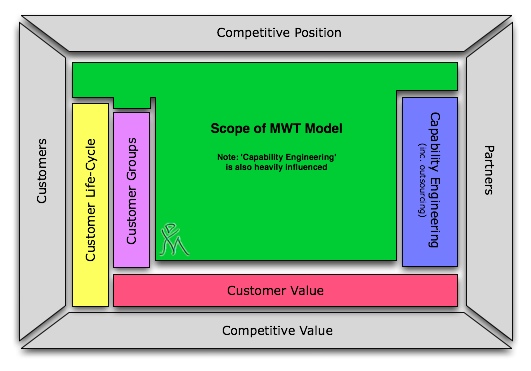The MWT Model is a replacement for the standard management practices of an organisation. It is based on the same premises that recognise that market-based economies create value more effectively than planned economies.
In this sense, the MWT Model is the natural conclusion of applying the forces that drive globalisation, such as ICT (information and communication technology) advances and market liberalisation, inwardly. Rather than looking at how these effect and enhance the market outside the firm, the model provides opportunies to expliot them inside the firm (and across supply chains, of course).
MWT is also the natural extension of how more sophisticated, value-driven, collaboration and ownership is enabled by technology advancement. This is the same force that gave rise to national (and increasingly, competitive) stock exchange systems when information processing technology improved sufficiently to support such exchanges.
However, the MWT Model is not simply a vague regurgitation of the wonder of self-organising systems. At the level of the firm, globalisation and the relative freeing up of markets already provides a mechanism of self-organisation. Firms grow or decline through an increasingly effective (and sometimes harsh) market of self-organisation.
Instead, the MWT Model provides practical mechanisms for managing organisations – and for taking advantage of the very technologies which could otherwise threaten the organisation through increased and more nimble competition.
So while the  MWT Model is a market-based management model, it is not a laissez-faire management model. Such a model would ignore the important structural elements of the economy which are already the result of the effective self-management of the boundaries between the market (the outside of the firm) and the organisation (the inside of the firm).
MWT Model is a market-based management model, it is not a laissez-faire management model. Such a model would ignore the important structural elements of the economy which are already the result of the effective self-management of the boundaries between the market (the outside of the firm) and the organisation (the inside of the firm).
Rather than take the approach that their is no effective way to add value to firms via intervention, the MWT Model recognises that organisations must manage and maintain a specifically constructed competitive position, an effective relationship with targeted customers and partners, and deliver targeted value.
These elements represent the context of the organisation, and the context of the MWT Model. Because the context of the firm and the context of the model can be defined in the same way, MWT Model exists within a familiar context. This can be shown by the accompanying figure which shows the scope of the MWT Model in the context of the organisation:
- Competitive Position
- Competitive Value
- Customers
- Partners
- Customer Value
- Customer Life-Cycle
- Customer Groups
- Capabilities
This list represents areas of enterprise strategic analysis which are not part of the MWT Model, but rather they provide the context under which the model operates. The exception is ‘Capabilities’ which is significantly effected by the MWT Model’s capability engineering processes and focus on service-based management.
Now it’s time to drill down into what the MWT Model actually is. The following blog post, on the Structure of the MWT Model, will decompose the model into its main components: Operationalised Brands, Technology-enabled Markets, Collaboration Architectures, The New MWT Hierarchy, and The MWT Management Transformation.
Powered by Qumana

